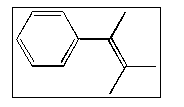|
1. Which of the following bonds undergoes stretching at the highest frequency?
(A) C=O
(B) C-O
(C) C=C
(D) C-C
2. Which of the following compounds gives an infrared spectrum with peaks at 3000-3500 cm-1?

(A)
1
(B)
2
(C)
3
(D)
4
3. What is the multiplicity
of the signal in the 1H NMR spectrum for the methyl protons of
2-methylpropane?
(A) singlet
(B) doublet
(C) triplet
(D) nonet
4. Which of the following combinations of peaks appears in the 1H NMR spectrum of diethyl ether, CH3CH2OCH2CH3?
(A) a triplet and a doublet
(B) a quartet and a sextet
(C) two singlets
(D) a triplet and a quartet
5. How many signals appear in
the proton-decoupled 13C NMR spectrum of 1,3-dibromobenzene?
(A) 1
(B) 2
(C) 3
(D) 4
6. How many signals appear in the proton-decoupled 13C NMR spectrum of the following compound?

(A) 7
(B) 8
(C) 9
(D) 11
7. The coupling constant,
J, between the protons of chloroethane is 7 Hz when the spectrum is obtained
at 250 MHz. What is the coupling constant between these protons when the
spectrum is acquired at 500 MHz?
(A) 3.5 Hz
(B) 7 Hz
(C) 14 Hz
(D) 21 Hz
8. What is the hydrogen
deficiency index for a compound with a molecular formula of C6H6Br2?
(A) 1
(B) 2
(C) 3
(D) 4
9. Which of the following compounds gives a 1H NMR spectrum consisting of only a singlet?
(A) 1,1-dibromopropane
(B) 1,2-dibromopropane
(C) 1,3-dibromopropane
(D) 2,2-dibromopropane
10. Which of the following compounds gives a 1H NMR spectrum consisting of only two triplets and a singlet?
(A) CH3CH(OCH3)2
(B) CH3OCH2CH2CH2CH2OCH3
(C) CH3OCH2CH2OCH3
(D) CH3OCH2CH(OH)CH3
|